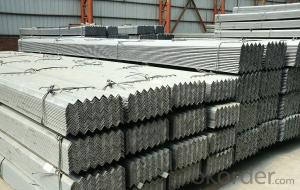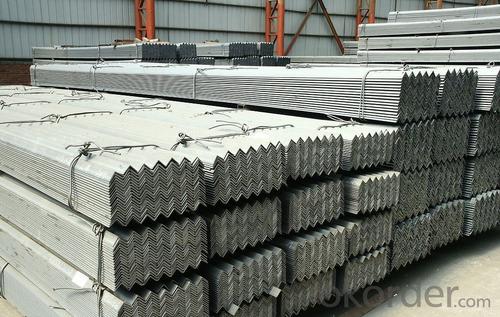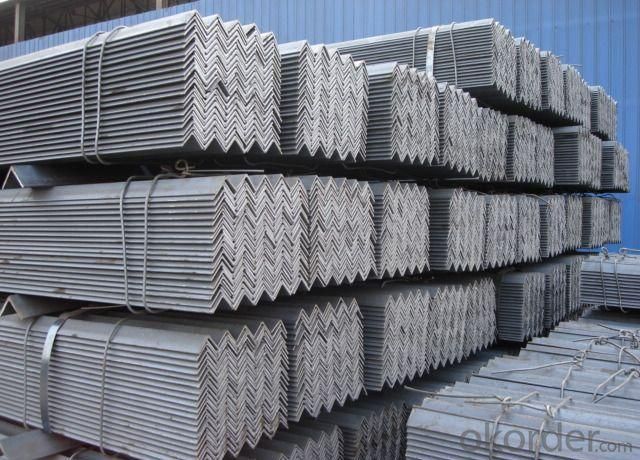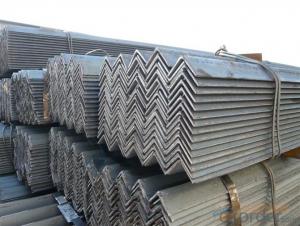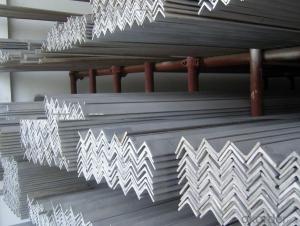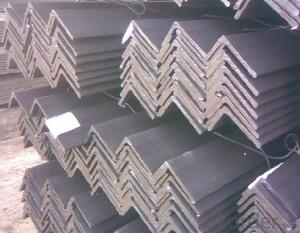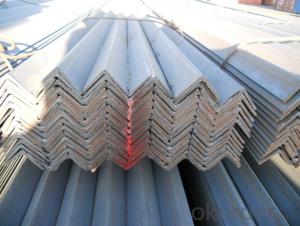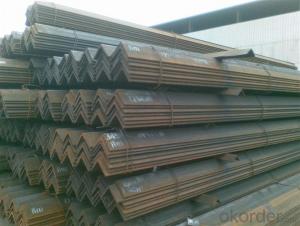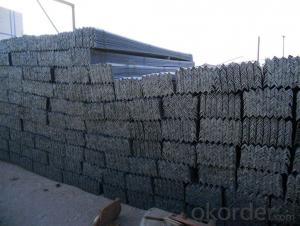GB Q345 Steel Angle with High Quality 100*100mm
- Loading Port:
- Tianjin
- Payment Terms:
- TT or LC
- Min Order Qty:
- 25 m.t
- Supply Capability:
- 10000 m.t/month
OKorder Service Pledge
OKorder Financial Service
You Might Also Like
Specifications of GB Q345 Steel Angle with High Quality 100*100mm:
1.Standards: GB
2.Material: Q345 or Equivalent
3.Length: 6m, 12m
4.Size:
| Size (mm) | Mass (kg/m) | Size (mm) | Mass (kg/m) |
| 100*100*6 | 9.366 | 100*100*10 | 15.120 |
| 100*100*7 | 10.830 | 100*100*12 | 17.898 |
| 100*100*8 | 12.276 |
Usage & Applications of GB Q345 Steel Angle with High Quality 100*100mm:
Trusses;
Transmission towers;
Telecommunication towers;
Bracing for general structures;
Stiffeners in structural use.
Packaging & Delivery of GB Q345 Steel Angle with High Quality 100*100mm:
1. Transportation: the goods are delivered by truck from mill to loading port, the maximum quantity can be loaded is around 40MTs by each truck. If the order quantity cannot reach the full truck loaded, the transportation cost per ton will be little higher than full load.
2. With bundles and load in 20 feet/40 feet container, or by bulk cargo, also we could do as customers' request.
3. Marks:
Color mark: There will be color marking on both end of the bundle for the cargo delivered by bulk vessel. That makes it easily to distinguish at the destination port.
Tag mark: There will be tag mark tied up on the bundles. The information usually including supplier logo and name, product name, made in China, shipping marks and other information request by the customer.
If loading by container the marking is not needed, but we will prepare it as customers' request.
FAQ:
Q1: Why buy Materials & Equipment from OKorder.com?
A1: All products offered byOKorder.com are carefully selected from China's most reliable manufacturing enterprises. Through its ISO certifications, OKorder.com adheres to the highest standards and a commitment to supply chain safety and customer satisfaction.
Q2: How do we guarantee the quality of our products?
A2: We have established an advanced quality management system which conducts strict quality tests at every step, from raw materials to the final product. At the same time, we provide extensive follow-up service assurances as required.
Q3: How soon can we receive the product after purchase?
A3: Within three days of placing an order, we will arrange production. The shipping date is dependent upon the quatity, how many sizes you want and the plan of production, but is typically 30 to 45 days from the beginning of production.
Images of GB Q345 Steel Angle with High Quality 100*100mm:
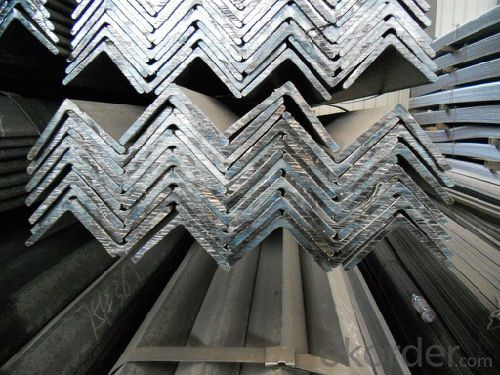
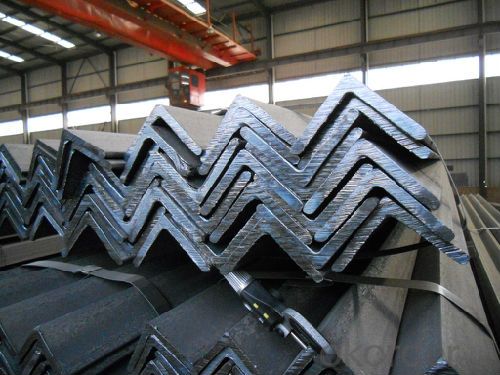
*If you would like to get our price, please inform us the size, standard/material and quantity. Thank you very much for your attention.
- Q: What are the standard specifications for steel angles?
- The standard specifications for steel angles include factors such as the size, thickness, length, and tolerance of the angle. These specifications may vary depending on the specific application and industry requirements.
- Q: How do steel angles contribute to the sustainability of transportation systems?
- Several ways contribute to the sustainability of transportation systems through the utilization of steel angles. To begin with, steel angles find wide use in constructing infrastructure, such as bridges, highways, and railway tracks. These structures boast a longer lifespan and necessitate fewer repairs and replacements compared to alternative materials. As a result, maintenance costs and resource consumption are reduced. Furthermore, steel angles possess exceptional durability and resistance to severe weather conditions. This quality ensures the longevity and safety of transportation systems. Consequently, the need for frequent repairs or replacements is minimized, thereby decreasing the overall environmental impact and carbon emissions associated with transportation infrastructure. In addition, steel angles possess a high strength-to-weight ratio, enabling the design of lighter and more fuel-efficient vehicles. Utilizing steel angles in the manufacturing process of automobiles, trains, and ships leads to reduced vehicle weight, thereby enhancing fuel efficiency and decreasing greenhouse gas emissions during operation. Moreover, steel angles can be easily recycled at the end of their lifecycle. Globally, steel is one of the most recycled materials, boasting a recycling rate of over 85%. By recycling steel angles, not only is the demand for virgin steel production reduced, but energy is also saved, and greenhouse gas emissions associated with extraction and manufacturing processes are decreased. Overall, the incorporation of steel angles in transportation systems promotes sustainability by fostering durability, decreasing maintenance needs, improving fuel efficiency, and enabling efficient recycling. These factors collectively contribute to minimizing the environmental impact and enhancing the long-term viability of transportation infrastructure.
- Q: Can steel angles be used in outdoor applications?
- Steel angles have a wide range of uses in outdoor settings. They are frequently employed in construction projects, serving as essential components in outdoor structures like fences, gates, and outdoor staircases. Moreover, they are extensively utilized in outdoor equipment and machinery, fulfilling purposes such as supporting brackets for solar panels or frames for outdoor signage. Thanks to their exceptional durability and resistance to corrosion, steel angles are capable of enduring outdoor elements such as rain, wind, and sunlight. Furthermore, these angles can be further fortified against rust and other types of corrosion through galvanization or the application of protective finishes. Overall, steel angles are a reliable and versatile option for outdoor applications due to their strength, durability, and resilience to various weather conditions.
- Q: How do steel angles perform in terms of electrical conductivity?
- Steel angles have low electrical conductivity due to the high resistance of steel to the flow of electric current.
- Q: How do steel angles contribute to the resiliency of a structure?
- Steel angles contribute to a structure's resiliency in multiple ways. Firstly, they distribute the load across different members, providing added structural support and stability. In construction projects, steel angles are often used as reinforcements or braces, enabling the transmission of forces and preventing excessive deflection or deformation. This helps the structure resist external forces like wind, earthquakes, or heavy loads, ultimately enhancing its overall resilience. Furthermore, steel angles possess high durability and corrosion resistance, further bolstering a structure's resiliency. Steel, as a material, boasts exceptional strength and longevity, making it particularly well-suited for enduring harsh environmental conditions and potential structural failures. This durability ensures the structure can withstand the test of time, reducing the need for frequent repairs or replacements and ultimately improving its overall resilience. Additionally, steel angles offer flexibility in design and construction, facilitating efficient load transfer and optimized structural configurations. They can be easily customized and fabricated to meet specific project requirements, guaranteeing the structure can be tailored to withstand various dynamic and static loads. This adaptability enhances the structure's resiliency by enabling it to adapt to changing conditions or future modifications. In summary, steel angles play a vital role in enhancing a structure's resiliency by providing additional support, durability, and flexibility. Their ability to distribute loads, resist external forces, and withstand harsh conditions ensures the structure can withstand unexpected events and maintain its integrity. As such, steel angles are an indispensable component of resilient construction practices.
- Q: What are the different types of steel angles connections?
- Construction and engineering projects utilize various steel angle connections. Some commonly used types are: 1. Welded Connection: Skilled welders join the angles using welding techniques, creating a robust and rigid connection. However, this method requires time and expertise. 2. Bolted Connection: Bolts, nuts, and washers connect the angles, allowing for easy disassembly and modification. It is popular for temporary structures or situations requiring future changes. Additional reinforcement like gussets or plates can be used. 3. Riveted Connection: In older steel structures and bridges, riveting was commonly employed. Rivets, which are metal pins with a head, are hammered into pre-drilled holes to form a permanent connection. 4. Clip Angle Connection: Clip angles, small steel angles, are bolted or welded to the main angles, providing additional support and reinforcement. This enhances the strength and stability of the primary connection. 5. Pinned Connection: Pinned connections enable rotational movement between angles, allowing for flexibility and load redistribution. A pin or bolt passes through holes in the angles, enabling free rotation. 6. Gusset Plate Connection: Gusset plates, flat steel plates, connect and reinforce the angles. They are typically bolted or welded to the angles, adding strength and stability to the connection. The selection of a steel angle connection depends on factors such as load-bearing requirements, structural design, installation ease, and future modifications. Each type has its own advantages and disadvantages, and engineers carefully choose the most suitable connection based on project-specific needs.
- Q: Can steel angles be used in railway infrastructure?
- Yes, steel angles can be used in railway infrastructure. Steel angles, also known as L-shaped structural steel, have a variety of applications in the construction industry, including railway infrastructure. They are commonly used in the fabrication of railway tracks, bridges, support structures, and other components of the railway system. Steel angles are preferred in railway infrastructure due to their high strength, durability, and versatility. They can withstand heavy loads and provide excellent structural support, making them suitable for the demanding conditions of railway tracks and structures. Steel angles are also resistant to corrosion, which is crucial for railway infrastructure exposed to harsh environmental conditions. In railway tracks, steel angles are often used as base plates, connecting the rails to the sleepers or ties. They provide stability and distribute the load evenly, ensuring the safe and smooth operation of trains. Steel angles are also used in the construction of bridges, where they serve as the main structural element for supporting the weight of the trains. Furthermore, steel angles can be easily fabricated and installed, making them a cost-effective choice for railway infrastructure projects. They can be cut, welded, and shaped to meet specific design requirements, allowing for efficient construction and customization. Overall, steel angles have proven to be a reliable and efficient choice for railway infrastructure. Their strength, durability, and versatility make them suitable for various applications in the railway system, contributing to the safety and efficiency of train operations.
- Q: What is the process of hot rolling steel angles?
- The production of steel angles through hot rolling comprises a series of procedures that convert raw materials into finished steel angles with specific dimensions and properties. Initially, the raw material, typically a billet or continuous casting, is heated to a temperature above its recrystallization point. This raises the steel's malleability and facilitates shaping. Subsequently, the heated billet enters a rolling mill, where it proceeds through a sequence of rollers. These rollers exert pressure on the billet, causing it to deform and adopt the form of an angle. The angle's shape is determined by the rollers, which possess a groove or profile that corresponds to the desired angle dimensions. During its passage through the rolling mill, the billet undergoes plastic deformation. This involves elongating and reducing its cross-sectional area, resulting in a longer and thinner shape. The deformation process molds the flanges (vertical sides) and web (horizontal section connecting the flanges) of the angle. To maintain the desired shape and dimensions, the steel angle may pass through multiple sets of rollers, each applying pressure and further shaping the angle. This continuous rolling process ensures consistent dimensions and smooth surfaces. Upon completion of the hot rolling process, the steel angles are cooled and straightened. This is typically achieved through water or air cooling methods. Rapid cooling strengthens and hardens the steel, while straightening eliminates any bends or twists in the angles. After cooling and straightening, the steel angles may undergo supplementary procedures such as cutting to the desired length, surface treatments like painting or galvanizing, and quality control inspections to ensure compliance with the required specifications. In summary, the hot rolling process for steel angles involves heating the raw material, passing it through rolling mills for shaping and deformation, cooling and straightening the angles, and ultimately finishing them to meet the desired specifications. This process yields high-quality steel angles that find extensive application in construction, manufacturing, and various other industries.
- Q: How are steel angles protected against abrasion?
- Steel angles find common applications in construction and industrial settings, where they are exposed to various forms of abrasion. To safeguard steel angles against abrasion, multiple techniques are employed. One prevalent approach involves the use of protective coatings, such as paints, epoxy coatings, or specialized coatings designed for abrasion resistance. These coatings act as a barrier between the steel surface and abrasive elements, preventing direct contact and minimizing wear caused by friction. Another method entails the application of rubber or plastic linings to the susceptible surfaces of steel angles. These linings absorb the impact of abrasive forces, cushioning the steel and reducing wear. Additionally, they provide an extra layer of protection against corrosion and chemical attacks. In certain cases, steel angles may undergo hardening or heat treatment. This process involves subjecting the steel to high temperatures followed by rapid cooling, altering the steel's microstructure to enhance hardness and resistance to abrasion. Heat-treated steel angles are commonly used in industries with high-wear environments, such as mining and material handling. Furthermore, engineers may choose to design steel angles with specific profiles or shapes that offer improved resistance to abrasion. These profiles may include rounded edges, chamfers, or other features that minimize direct contact with abrasive materials. Overall, protecting steel angles from abrasion involves a combination of protective coatings, linings, heat treatment, and thoughtful design. Implementing these measures significantly prolongs the lifespan and performance of steel angles, reducing maintenance costs and ensuring durability in abrasive environments.
- Q: Can steel angles be used for building frames?
- Indeed, the utilization of steel angles is feasible when constructing frames. In the realm of construction, steel angles are frequently employed for framing purposes owing to their robustness and adaptability. They are commonly utilized in the formation of the structural skeleton of edifices, such as the construction of walls, floors, and roofs. Steel angles furnish stability and support to the overall structure and can be effortlessly welded or bolted together to fabricate a sturdy and enduring frame. Moreover, steel angles are obtainable in a variety of sizes and thicknesses, allowing for customization and adaptation to diverse building requisites. All in all, steel angles are a favored option for constructing frames due to their strength, versatility, and user-friendly nature.
Send your message to us
GB Q345 Steel Angle with High Quality 100*100mm
- Loading Port:
- Tianjin
- Payment Terms:
- TT or LC
- Min Order Qty:
- 25 m.t
- Supply Capability:
- 10000 m.t/month
OKorder Service Pledge
OKorder Financial Service
Similar products
Hot products
Hot Searches
Related keywords
